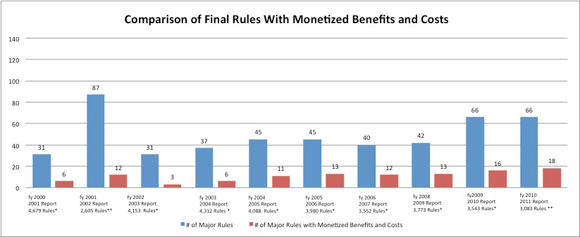- | Regulation Regulation
- | Data Visualizations Data Visualizations
- |
Comparison of Final Rules with Monetized Benefits and Costs
It is a commonplace to hear presidents and OMB officials claim that the total benefits of regulations exceed their total costs. In this week’s chart, Mercatus Center policy director Richard Williams highlights the disparity between the total number of rules and the number of rules with monetized benefits and costs in order to demonstrate that such claims simply cannot be validated.
It is a commonplace to hear presidents and OMB officials claim that the total benefits of regulations exceed their total costs. In this week’s chart, Mercatus Center policy director Richard Williams highlights the disparity between the total number of rules and the number of rules with monetized benefits and costs in order to demonstrate that such claims simply cannot be validated.
The White House claims that it uses “cost-benefit analysis in a highly disciplined way” and that the net benefits of rules issued in the first two years have been over $35 billion, which it asserts is “over three times the corresponding number in the first two years of the Clinton administration and over ten times the corresponding number in the first two years of the Bush Administration.” This is an extraordinary boast if true—and one that is conveniently difficult to verify.
There are many reasons why such a figure is not known for sure, including the incompleteness or poor quality of analysis, but one glaring reason stands out. For the past 15 years, the Office of Management and Budget has provided Congress with reports on the combined annual benefits and costs of federal agency regulatory programs. All have reported benefits exceeding costs, and as such, these reports are by design misleading.
For each year the actual number of regulations that have quantified benefits and costs is only a tiny fraction of the overall number of final rules. In the fiscal year 2010 report, for example, there were more than 3,000 final rules, and only 18 of them had quantified benefits and costs. Regulatory impact analyses are only required for economically significant rules, those with impacts greater than $100 million in any given year. But agencies aren’t complying with that requirement. In 2010, there were 66 economically significant rules, so only about a quarter of the rules received the full analysis.
* Taken from the annual OMB Report to Congress for that year
** Taken from GAO Congressional Review Act Reports, Excludes Independent Agencies


